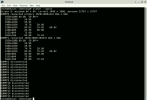I am using teamviewer/anydesk/rustdesk to connect remotely. They support multiple displays I believe since I can see the switch monitor button, but even in xfce settings there's no monitor (I have just tried with virtual monitor using dummy driver but it still showed only red hat 15 inch).Unless you're using SPICE, VNC and RDP completely ignore that VGA card
How to make a linux Xorg based os recognize or use multiple screens without a graphic card?
- Thread starter kikoko
- Start date
You are using an out of date browser. It may not display this or other websites correctly.
You should upgrade or use an alternative browser.
You should upgrade or use an alternative browser.
I feel like dummy driver isn't working at all, in general. I was going to give up on dummy driver after dozen attempts but I've kept trying and adjusting missing things according to the logs, so here's a working one, its minimal working for me, no multiple screens:
I assume black screen in no vnc is a normal behavior for dummy driver, however i'd like to see whats going on there plus have additional screen as well.
Code:
Section "Monitor"
Identifier "Monitor0"
HorizSync 30-83
VertRefresh 50-76
Modeline "1920x1080_60.00" 173.00 1920 2048 2248 2576 1080 1083 1088 1120 -hsync +vsync
DisplaySize 1920 1080
EndSection
Section "Device"
Identifier "DummyDevice0"
Driver "dummy"
VideoRam 256000
Option "MetaModes" "1920x1080_60.00"
EndSection
Section "Screen"
Identifier "Screen0"
Device "DummyDevice0"
Monitor "Monitor0"
DefaultDepth 24
SubSection "Display"
Depth 24
Modes "1920x1080_60.00"
Virtual 1920 1080
EndSubSection
Option "Output" "DUMMY0"
Option "Monitor-DUMMY0" "Monitor0"
EndSection
Section "ServerLayout"
Identifier "X.org Configured"
Screen 0 "Screen0" 0 0
EndSection
Section "ServerFlags"
Option "IgnoreEDID" "true"
EndSection
Section "Extensions"
Option "Composite" "Enable"
EndSectionI assume black screen in no vnc is a normal behavior for dummy driver, however i'd like to see whats going on there plus have additional screen as well.
Last edited:
You seem to be stuck on trying to set up an emulated display for X to use, presumably because the remote access software you've chosen basically does "screen scraping" on an existing desktop. It grabs the current screen and encodes it for remote viewing. Ergo for multiple monitors to work you need to have a multi-monitor-supporting fake video card.
But as someone previously described, none of the options quite work that way. The only one that offers multi-monitor at all is SPICE and it doesn't work the way you would like it to.
There is another way to do this. Emulated hardware is completely irrelevant for XRDP, VNC, or Chrome Remote Desktop. Those products do their own display emulation using a modified X-server. They never touch the actual display hardware except possibly for enabling some 3D acceleration. They will work even if there is no display hardware at all. This is the way remote display is normally done on headless Linux boxes.
XRDP even does multiple monitors (using it now). Getting sound to work is annoying though.
Or just use SPICE with virt-viewer.
But as someone previously described, none of the options quite work that way. The only one that offers multi-monitor at all is SPICE and it doesn't work the way you would like it to.
There is another way to do this. Emulated hardware is completely irrelevant for XRDP, VNC, or Chrome Remote Desktop. Those products do their own display emulation using a modified X-server. They never touch the actual display hardware except possibly for enabling some 3D acceleration. They will work even if there is no display hardware at all. This is the way remote display is normally done on headless Linux boxes.
XRDP even does multiple monitors (using it now). Getting sound to work is annoying though.
Or just use SPICE with virt-viewer.
Last edited:
This should work with the dummy driver, but the config you posted only has 1 monitor/screen. You need 2 screens, 2 monitors connected to 1 dummy device
This is what ChatGPT tells me, which looks correct-ish:
Note that something like this works for containers and Xorg compatible software, whether your particular closed source software understands this, I don’t know.
This is what ChatGPT tells me, which looks correct-ish:
INI:
Section "Module"
Load "dummy"
EndSection
Section "Device"
Identifier "Dummy0"
Driver "dummy"
VideoRam 256000
Option "IgnoreEDID" "True"
Option "NoDDC" "True"
Option "VirtualHeads" "2" # Allow for two virtual monitors
EndSection
Section "Monitor"
Identifier "Monitor0"
Option "DPMS" "false" # Disable DPMS for the dummy monitor
HorizSync 30-83
VertRefresh 56-75
Modeline "1920x1080_60.00" 138.50 1920 2040 2240 2560 1080 1084 1094 1120 -HSync +Vsync
EndSection
Section "Monitor"
Identifier "Monitor1"
Option "DPMS" "false" # Disable DPMS for the second dummy monitor
HorizSync 30-83
VertRefresh 56-75
Modeline "1920x1080_60.00" 138.50 1920 2040 2240 2560 1080 1084 1094 1120 -HSync +Vsync
EndSection
Section "Screen"
Identifier "Screen0"
Device "Dummy0"
Monitor "Monitor0"
DefaultDepth 24
SubSection "Display"
Depth 24
Modes "1920x1080_60.00"
EndSubSection
EndSection
Section "Screen"
Identifier "Screen1"
Device "Dummy0"
Monitor "Monitor1"
DefaultDepth 24
SubSection "Display"
Depth 24
Modes "1920x1080_60.00"
EndSubSection
EndSection
Section "ServerLayout"
Identifier "Layout0"
Screen 0 "Screen0" 0 0
Screen 1 "Screen1" RightOf "Screen0" # Position Screen1 to the right of Screen0
InputDevice "Keyboard0" "CoreKeyboard"
InputDevice "Mouse0" "CorePointer"
EndSectionNote that something like this works for containers and Xorg compatible software, whether your particular closed source software understands this, I don’t know.
Last edited:
I've got it working as I wanted by the way, I will be posting later, and, no, ai solutions have no idea on how to use proper flags in modern xorg, all ai solutions are outdated in those terms, and in general, are trash when it comes to writing code/solving problems lol.
Had to check xorg's src to figure out how to make it work correctly.

And just to prove that my remote view application does not spawn anything:

Had to check xorg's src to figure out how to make it work correctly.

And just to prove that my remote view application does not spawn anything:

Last edited:
I am asking because its basically using modesetting driver either way, so I have no idea.
Also do you think its possible to have 2 devices (and monitors) one of which will be dummy and the other have bus id and modesetting as driver? Asking to not spend my time on trying to configure it in xorg, if its an impossible thing to do.
Asking specifically about this case since I am not really a novnc type of user, I do not mind what my xorg uses since I am not passing my gpu to the os, so is virtio-gpu being used exclusively when you need to pass your real video card into the os? Like I do not understand whether its using igpu or not? What is the whole point behind virtio gpu, and where it can give me performance over default option?
Also do you think its possible to have 2 devices (and monitors) one of which will be dummy and the other have bus id and modesetting as driver? Asking to not spend my time on trying to configure it in xorg, if its an impossible thing to do.
Asking specifically about this case since I am not really a novnc type of user, I do not mind what my xorg uses since I am not passing my gpu to the os, so is virtio-gpu being used exclusively when you need to pass your real video card into the os? Like I do not understand whether its using igpu or not? What is the whole point behind virtio gpu, and where it can give me performance over default option?
Last edited:

